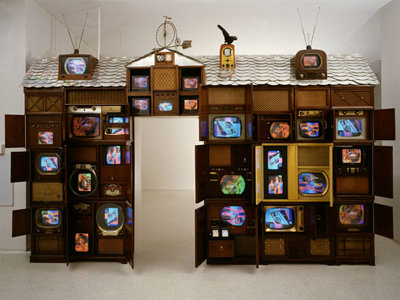Nam June Paik
dal 23/3/2007 al 20/4/2007
Segnalato da
23/3/2007
Nam June Paik
James Cohan Gallery, New York
His combinations of music, video, sculpture, performance, television broadcast and technological experimentation offer subversive and often humorous critiques of a culture consumed by technology. Installed in the front gallery, "W3", is reflective of Paik's expression "electronic super highway". In the main gallery space are "In-Flux House" and "Tower". The former is an architectural structure of old TV cabinets and monitors in the form of an ordinary house.

Solo show
Widely exhibited throughout his career, Paik worked closely with artists John Cage, Joseph Beuys, Charlotte Moorman and others involved in the Fluxus movement, focusing on immediate, temporal and chance encounters between ideas, the object and the public. His innovative combinations of music, video, sculpture, performance, television broadcast and technological experimentation offer subversive and often humorous critiques of a culture consumed by technology. The artist died at age 73 in January 2006.
Installed in the front gallery, W3, 1994, is reflective of Paik's expression "electronic super highway," a term that foreshadowed how technology would come to connect diverse cultures at high speeds. The work incorporates 64 color TVs installed in zigzagging patterns on the ceilings and floors of a dark room. Previously exhibited in the traveling exhibition The Electronic Super Highway: Travels with Nam June Paik, each television screen captures an image for a split second before it jumps to the next- a tour de force of images chasing images.
In the main gallery space are In-Flux House, 1993, and Tower, 2001. The former is an architectural structure of old TV cabinets and monitors in the form of an ordinary house. The implications point to the pervasive nature of the medium that invades, to ever greater extent, both public and private spaces- from Times Square to the suburban home. Tower, 2001, is a 15 foot structure that incorporates neon lighting with old TV cabinets and monitors displaying video footage of communication towers such as the World Trade Center. The work seems to suggest Paik's interest in the phenomenon of electronic communication and his prescient pre-internet notion of the "the global village."
Two robot figures; Karen Blixen Robot, 1996, a tribute to the author of Out of Africa, and From Neander Valley to Silicon Valley, 1994, will also be on view. The former is an arrangement of old TV monitors adorned in stereotypical ornaments from Blixen's adopted Africa, including batik fabric, a straw hat and tribal masks, and was commissioned as part of a series of six robots based on important Danish figures for the Electronic Undercurrents exhibition at the Statens Museum for Kunst in Copenhagen, Denmark. From Neander Valley to Silicon Valley, 1994, combines old TV monitors with animal fur and prehistoric tools- a work that can be understood as a humorous representation of a theme central to Paik's work; man's ability to shape and transform technology over time, from pictographs to the present internet age.
Image Nam June Paik, In-Flux House, 1993. Mixed media, 140 × 212 × 24 inches
James Cohan Gallery
533 West 26th Street 212 New York USA



